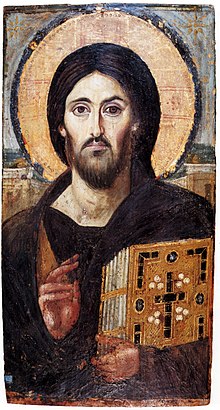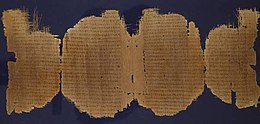
A | B | C | D | E | F | G | H | CH | I | J | K | L | M | N | O | P | Q | R | S | T | U | V | W | X | Y | Z | 0 | 1 | 2 | 3 | 4 | 5 | 6 | 7 | 8 | 9
Jesus | |
|---|---|
 | |
| Born | c. 6 to 4 BC[a] |
| Died | AD 30 or 33 (aged 33 or 38) |
| Cause of death | Crucifixion[b] |
| Known for | Central figure of Christianity Major prophet in Islam and Druze Faith Manifestation of God in Baháʼí Faith |
| Parents | |
Jesus[d] (c. 6 to 4 BC – AD 30 or 33), also referred to as Jesus Christ,[e] Jesus of Nazareth, and many other names and titles, was a first-century Jewish preacher and religious leader.[10] He is the central figure of Christianity, the world's largest religion. Most Christians believe Jesus to be the incarnation of God the Son and the awaited Jewish Messiah, or Christ, that is prophesied in the Old Testament.
Virtually all modern scholars of antiquity agree that Jesus existed historically.[f] Accounts of Jesus's life are contained in the Gospels, especially the four canonical Gospels in the New Testament. Academic research has yielded various views on the historical reliability of the Gospels and how closely they reflect the historical Jesus.[18][g][21][22]
Jesus was circumcised at eight days old, was baptized by John the Baptist as a young adult, and after 40 days and nights of fasting in the wilderness, began his own ministry. Being an itinerant teacher, he was often referred to as "rabbi".[23] Jesus often debated with fellow Jews on how to best follow God, engaged in healings, taught in parables, and gathered followers, among whom twelve were appointed as his chosen disciples. He was arrested in Jerusalem and tried by the Jewish authorities,[24] turned over to the Roman government, and crucified on the order of Pontius Pilate, the Roman prefect of Judaea. After his death, his followers became convinced that he rose from the dead, and following his ascension, the community they formed eventually became the early Christian Church that expanded as a worldwide movement.[25] It is hypothesized that accounts of his teachings and life were initially conserved by oral transmission, which was the source of the written Gospels.[26]
Christian theology includes the beliefs that Jesus was conceived by the Holy Spirit, was born of a virgin named Mary, performed miracles, founded the Christian Church, died by crucifixion as a sacrifice to achieve atonement for sin, rose from the dead, and ascended into Heaven, from where he will return. Commonly, Christians believe Jesus enables people to be reconciled to God. The Nicene Creed asserts that Jesus will judge the living and the dead, either before or after their bodily resurrection, an event tied to the Second Coming of Jesus in Christian eschatology. The great majority of Christians worship Jesus as the incarnation of God the Son, the second of three prosopons of the Trinity.[h] The birth of Jesus is celebrated annually, generally on 25 December,[i] as Christmas. His crucifixion is honoured on Good Friday and his resurrection on Easter Sunday. The world's most widely used calendar era—in which the current year is AD 2024 (or 2024 CE)—is based on the approximate birthdate of Jesus.[27]
Jesus is also revered in Islam, the Baháʼí Faith, and the Druze Faith. In Islam, Jesus (often referred to by his Quranic name ʿĪsā) is considered the penultimate prophet of God and the messiah, who will return before the Day of Judgement. Muslims believe Jesus was born of the virgin Mary but was neither God nor a son of God. Most Muslims do not believe that he was killed or crucified but that God raised him into Heaven while he was still alive.[j] In contrast, Judaism rejects the belief that Jesus was the awaited messiah, arguing that he did not fulfill messianic prophecies, was not lawfully anointed and was neither divine nor resurrected.
Name
| Part of a series on |
 |

A typical Jew in Jesus's time had only one name, sometimes followed by the phrase "son of ", or the individual's hometown.[28] Thus, in the New Testament, Jesus is commonly referred to as "Jesus of Nazareth".[k] Jesus's neighbours in Nazareth referred to him as "the carpenter, the son of Mary and brother of James and Joses and Judas and Simon", "the carpenter's son", or "Joseph's son"; in the Gospel of John, the disciple Philip refers to him as "Jesus son of Joseph from Nazareth".
The English name Jesus, from Greek Iēsous, is a rendering of Joshua (Hebrew Yehoshua, later Yeshua), and was not uncommon in Judea at the time of the birth of Jesus. Popular etymology linked the names Yehoshua and Yeshua to the verb meaning "save" and the noun "salvation".[29] The Gospel of Matthew tells of an angel that appeared to Joseph instructing him "to name him Jesus, for he will save his people from their sins".[30]
Jesus Christ
Since the early period of Christianity, Christians have commonly referred to Jesus as "Jesus Christ".[31] The word Christ was a title or office ("the Christ"), not a given name.[32][33] It derives from the Greek Χριστός (Christos),[34][35] a translation of the Hebrew mashiakh (משיח) meaning "anointed", and is usually transliterated into English as "messiah".[36] In biblical Judaism, sacred oil was used to anoint certain exceptionally holy people and objects as part of their religious investiture.[37]
Christians of the time designated Jesus as "the Christ" because they believed him to be the messiah, whose arrival is prophesied in the Hebrew Bible and Old Testament. In postbiblical usage, Christ became viewed as a name—one part of "Jesus Christ". Etymons of the term Christian (meaning a follower of Christ) have been in use since the 1st century.[38]
Life and teachings in the New Testament
| Events in the |
| Life of Jesus according to the canonical gospels |
|---|
 |
|
Portals: |
Canonical gospels

The four canonical gospels (Matthew, Mark, Luke, and John) are the foremost sources for the life and message of Jesus.[28] But other parts of the New Testament also include references to key episodes in his life, such as the Last Supper in 1 Corinthians 11:23–26.[39][40][41][42] Acts of the Apostles[43] refers to Jesus's early ministry and its anticipation by John the Baptist.[44][45][10] Acts 1:1–11[46] says more about the Ascension of Jesus[47] than the canonical gospels do.[48] In the undisputed Pauline letters, which were written earlier than the Gospels, Jesus's words or instructions are cited several times.[49][l]
Some early Christian groups had separate descriptions of Jesus's life and teachings that are not in the New Testament. These include the Gospel of Thomas, Gospel of Peter, and Gospel of Judas, the Apocryphon of James, and many other apocryphal writings. Most scholars conclude that these were written much later and are less reliable accounts than the canonical gospels.[52][53][54]
Authorship, date, and reliability
The canonical gospels are four accounts, each by a different author. The authors of the Gospels are pseudonymous, attributed by tradition to the four evangelists, each with close ties to Jesus:[55] Mark by John Mark, an associate of Peter;[56] Matthew by one of Jesus's disciples;[55] Luke by a companion of Paul mentioned in a few epistles;[55] and John by another of Jesus's disciples,[55] the "beloved disciple".[57]
According to the Marcan priority, the first to be written was the Gospel of Mark (written AD 60–75), followed by the Gospel of Matthew (AD 65–85), the Gospel of Luke (AD 65–95), and the Gospel of John (AD 75–100).[58] Most scholars agree that the authors of Matthew and Luke used Mark as a source for their gospels. Since Matthew and Luke also share some content not found in Mark, many scholars assume that they used another source (commonly called the "Q source") in addition to Mark.[59]
One important aspect of the study of the Gospels is the literary genre under which they fall. Genre "is a key convention guiding both the composition and the interpretation of writings".[60] Whether the gospel authors set out to write novels, myths, histories, or biographies has a tremendous impact on how they ought to be interpreted. Some recent studies suggest that the genre of the Gospels ought to be situated within the realm of ancient biography.[61][62][63] Although not without critics,[64] the position that the Gospels are a type of ancient biography is the consensus among scholars today.[65][66]
Concerning the accuracy of the accounts, viewpoints run the gamut from considering them inerrant descriptions of Jesus's life,[67] to doubting whether they are historically reliable on a number of points,[68] to considering them to provide very little historical information about his life beyond the basics.[69][70] According to a broad scholarly consensus, the Synoptic Gospels (the first three—Matthew, Mark, and Luke) are the most reliable sources of information about Jesus.[71][72][28]
Comparative structure and content
| Part of a series on |
| Christianity |
|---|
 |
